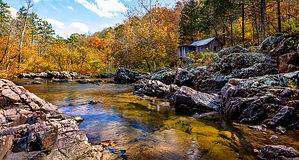Pennsylvania is home to an incredible variety of flowering trees that add vibrant splashes of color to its landscape. From the delicate blossoms of dogwoods to the stunning pink blooms of magnolias, this article showcases 24 magnificent flowering trees found in Pennsylvania. Explore the natural beauty that awaits you within the Keystone State’s diverse flora.
Home gardeners, wildlife, and pollinators love flowering trees in Pennsylvania for their beauty and the many benefits they provide. These trees attract butterflies, birds, and other wildlife, providing valuable habitat and food sources. The flowers produce nectar and pollen, which is essential for pollinators like bees, hummingbirds, and moths. Blossoms brighten yards and gardens with vibrant colors and fragrances. In addition, flowering trees provide shade, help reduce pollution, and provide food and shelter for animals. Therefore, it is no wonder why home gardeners, wildlife, and pollinators are so fond of flowering trees in Pennsylvania.
1. Japanese Tree Lilac
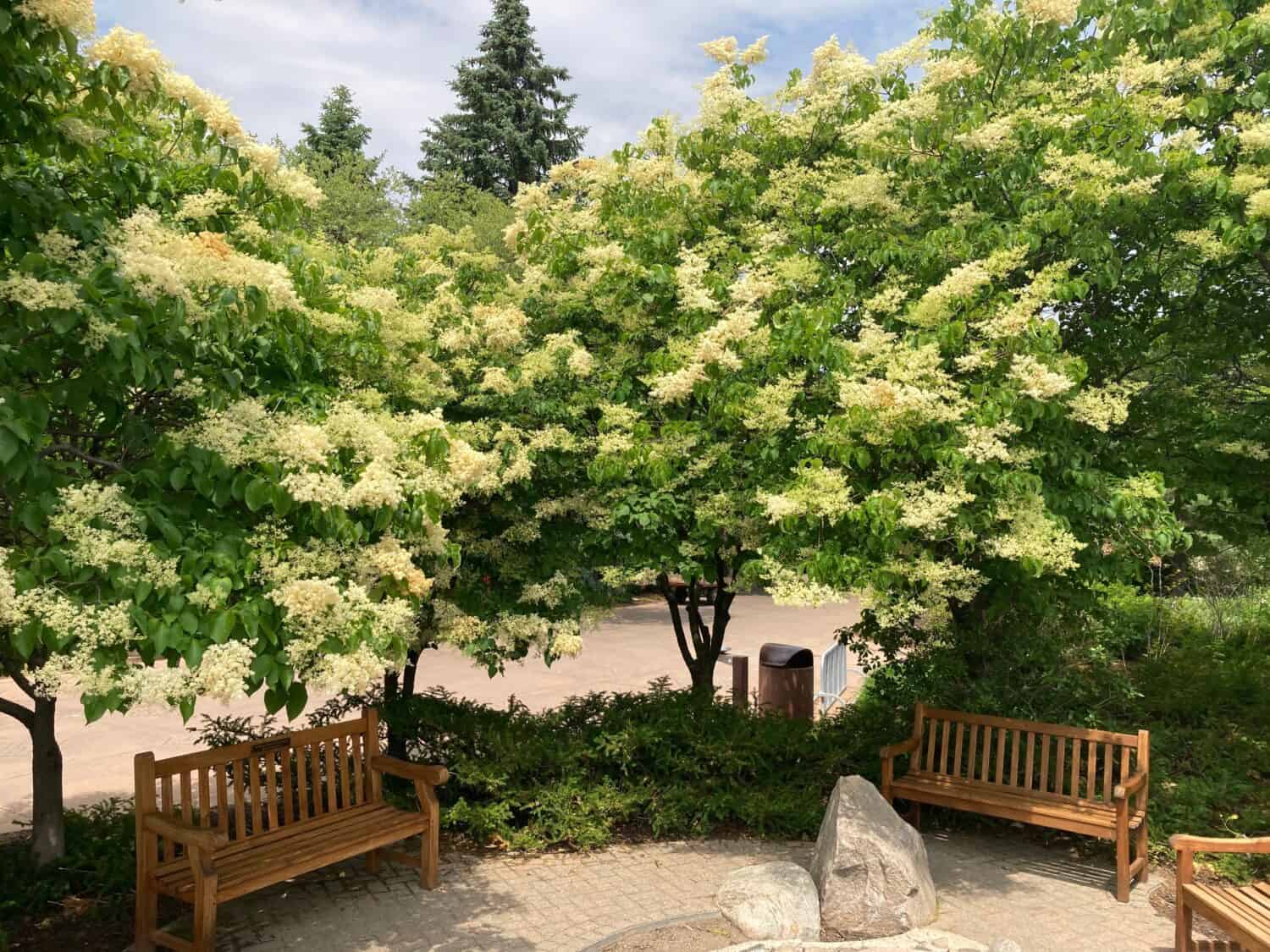
If you need a stunning flowering tree for Pennsylvania, consider the Japanese tree lilac.
©Jules Johnson/Shutterstock.com
The Japanese tree lilac is a beautiful deciduous flowering tree. To successfully grow one, plant it in a sunny location with well-drained soil. Water the tree regularly in its first year to help it establish itself. Prune it in early spring to maintain a neat shape and to encourage flowers. The tree grows to a height of 20-30 feet and has white flowers that appear in mid-summer. They are fragrant and attract birds and butterflies to the garden. With its attractive foliage and flowers, the Japanese tree lilac is a great addition to any Pennsylvania garden.
2. Crepe Myrtle

Crepe myrtle trees are absolutely covered in flowers.
©Noel V. Baebler/Shutterstock.com
Another flowering tree to add to your Pennsylvania garden is crepe myrtle. Grow crepe myrtle in full sun to partial shade. This flowering shrub requires well-drained soil and can tolerate dry conditions. Plant in spring or fall and water frequently until the plant is established. Prune the plant in late winter or early spring to maintain the desired shape and size. Crape Myrtle has an upright habit with arching branches and can reach up to twenty feet in height and width. Its trunk is usually straight, and its bark is smooth and gray. Its foliage is glossy and dark green with showy clusters of pink, purple, or white flowers in mid to late summer.
3. Chaste Tree

The blossoms of chaste trees will keep the bees coming back for more.
©Wut_Moppie/Shutterstock.com
The chaste tree is a beautiful flowering shrub that can reach up to 10 feet in height. It has attractive grey-green foliage and produces an abundance of fragrant, lilac-pink blooms in the summer months. To grow a chaste tree, one must plant it in full sun or partial shade in well-drained soil. Water it regularly and fertilize it in spring. Pruning is not necessary, but it can help keep the tree in shape. With proper care, it will reward you with its lovely blossoms and foliage for years to come.
4. Plum Tree
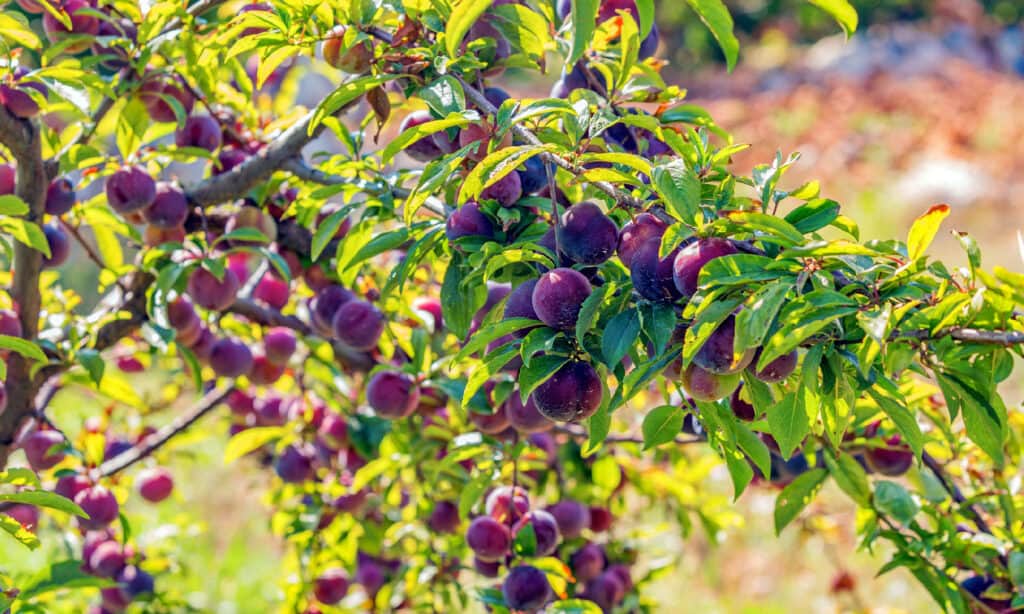
Both flowering ornamental plum trees and fruiting plum trees have gorgeous flowers.
©iStock.com/Funtay
A flowering plum tree is a beautiful sight to behold. With its delicate pink blossoms, its dark green foliage, and its elegant branches, it adds a touch of grace to any landscape. To grow a healthy plum tree, it is important to choose a sunny location and provide regular watering and occasional pruning. With proper care, a flowering plum tree will thrive and provide a stunning display of color and beauty.
5. Crabapple Tree
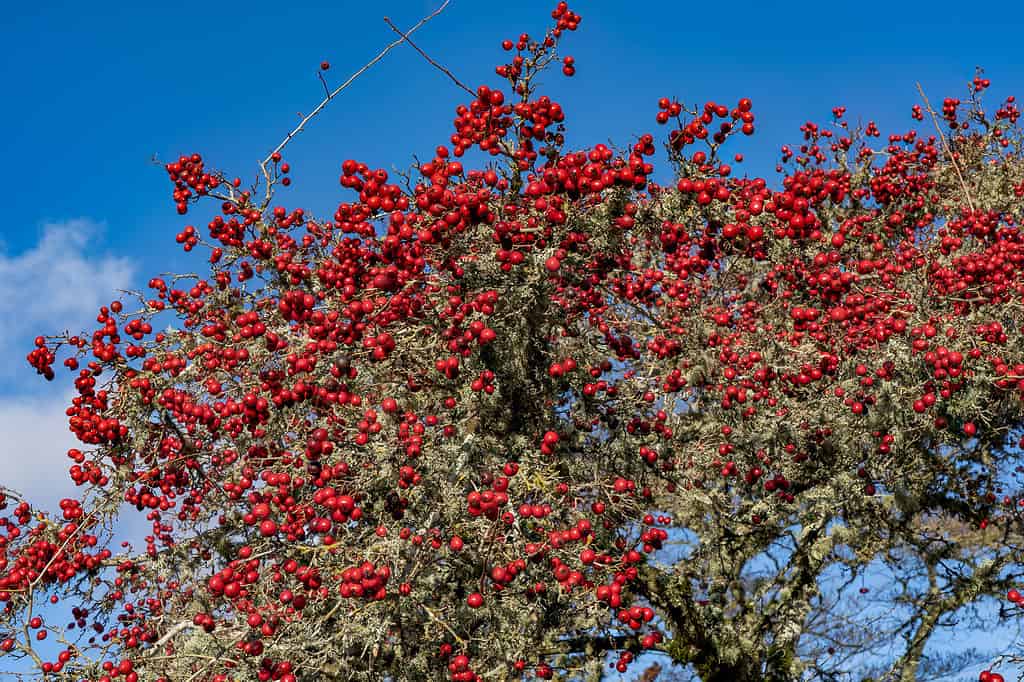
Healthy crabapple trees will produce hundreds of fruits and flowers.
©Bob Pool/Shutterstock.com
A crabapple tree is a deciduous tree with a stout trunk and spreading branches. It typically has a rounded crown and a height of 25 feet. Its leaves are a deep, glossy green, and its bark is rough and scaly. In the spring, its white or pink blossoms light up the sky, and in the summer, its small, red-to-yellow fruits appear. To grow a crabapple tree, plant it in well-drained soil and give it full sun. Prune it regularly to promote strong, healthy growth. Make sure to water it during periods of drought and fertilize it annually.
6. Star Magnolia
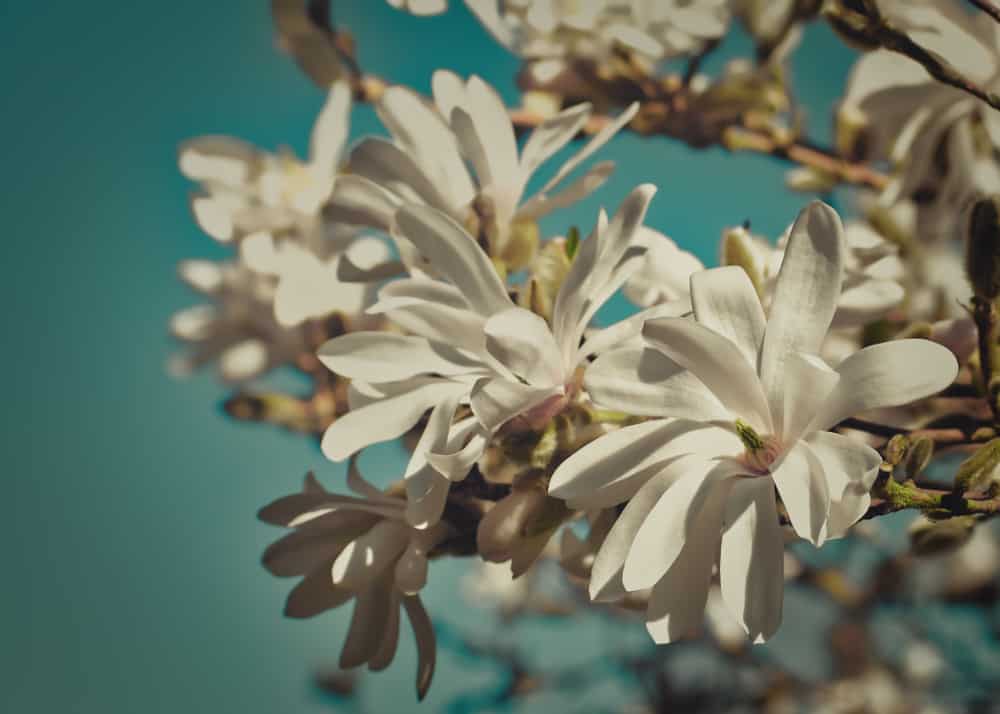
The flowers of star magnolias smell deliciously sweet.
©SwedishStockPhotos/Shutterstock.com
A star magnolia is a beautiful flowering tree with large, stunning white blooms that appear before its oval-shaped leaves emerge. Its bark is smooth and gray, adding to its eye-catching appearance. To grow a star magnolia, find a location with full to partial sun and moist, well-drained soil. Prune and shape as needed and fertilize a few times a year. With proper care, the tree will reach a height of up to 20 feet and a spread of 15 feet.
7. Flowering Pear Tree
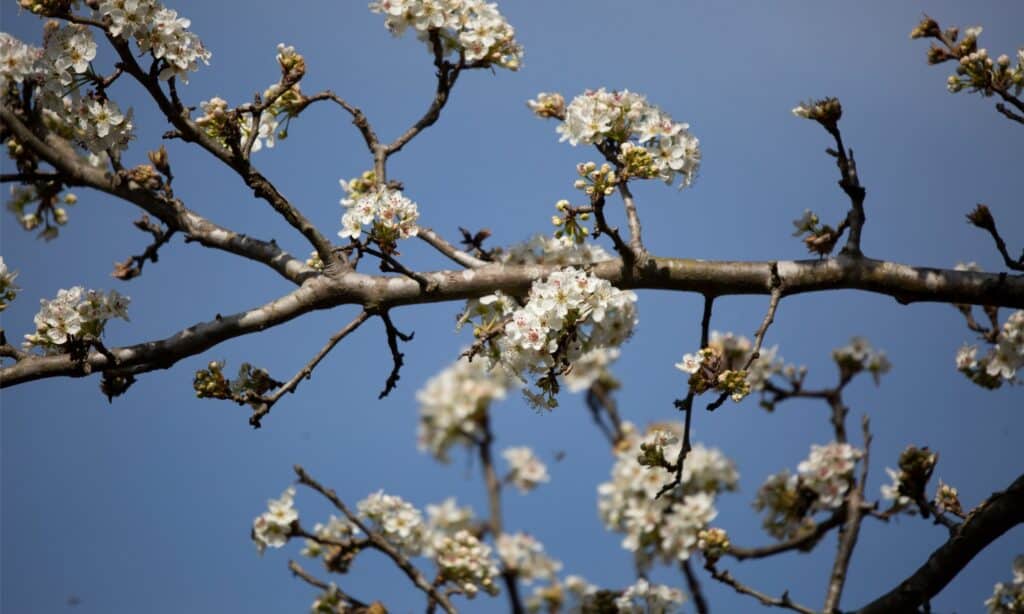
The Bradford pear doesn’t produce edible pears, but it does have gorgeous flowers.
©iStock.com/tornado98
A flowering pear tree is an attractive, deciduous tree with a rounded crown and white blooms in the spring. It has an upright, oval shape, and its trunk is usually straight and slender. Its leaves are simple and alternate, with a glossy, dark green color. The bark is smooth and grey, with occasional white patches. To grow a flowering pear tree, it needs full sun and well-drained soil. Prune the tree when it is young to maintain the desired shape and size. Regular fertilization and watering are necessary to ensure healthy growth.
8. Hawthorn
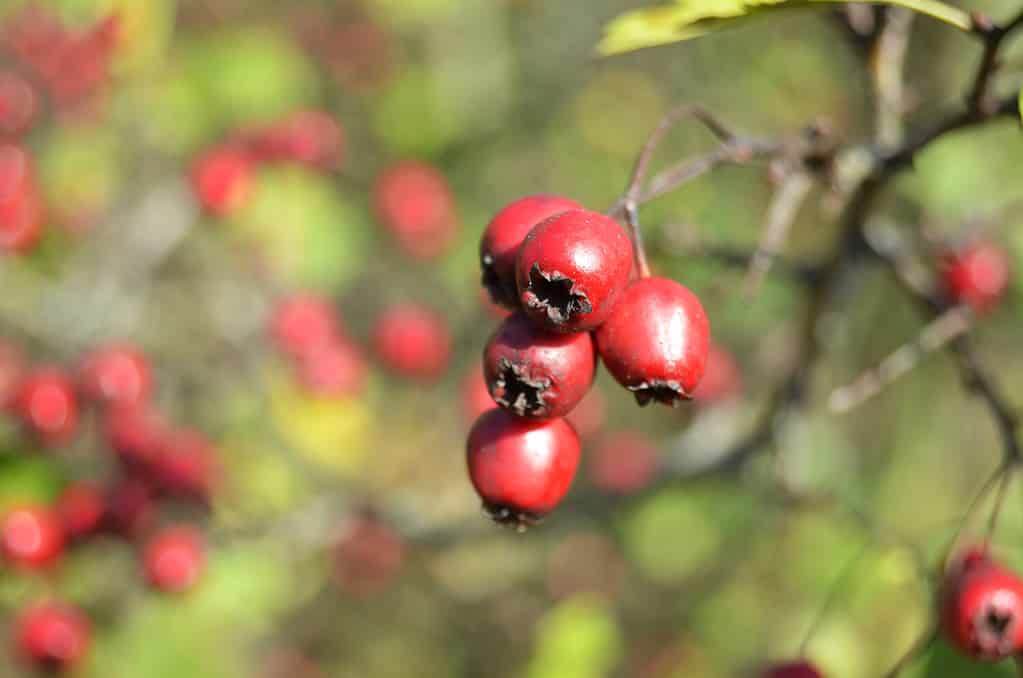
If you need a great flowering tree in Pennsylvania, consider the flowering hawthorn. It also has berries!
©Tereza Koudelkova/Shutterstock.com
A hawthorn tree has a gnarled, twisted trunk with thick, sharp thorns. Its branches are covered in dark green, glossy leaves, and delicate white flowers in the springtime. In the fall, its leaves turn a vibrant red, and its small, round berries become ripe and edible. To grow a hawthorn tree, plant it in full sun or partial shade and water regularly to get it established. Prune in winter to encourage a healthy form and to remove any dead or diseased branches.
9. Fringe Tree
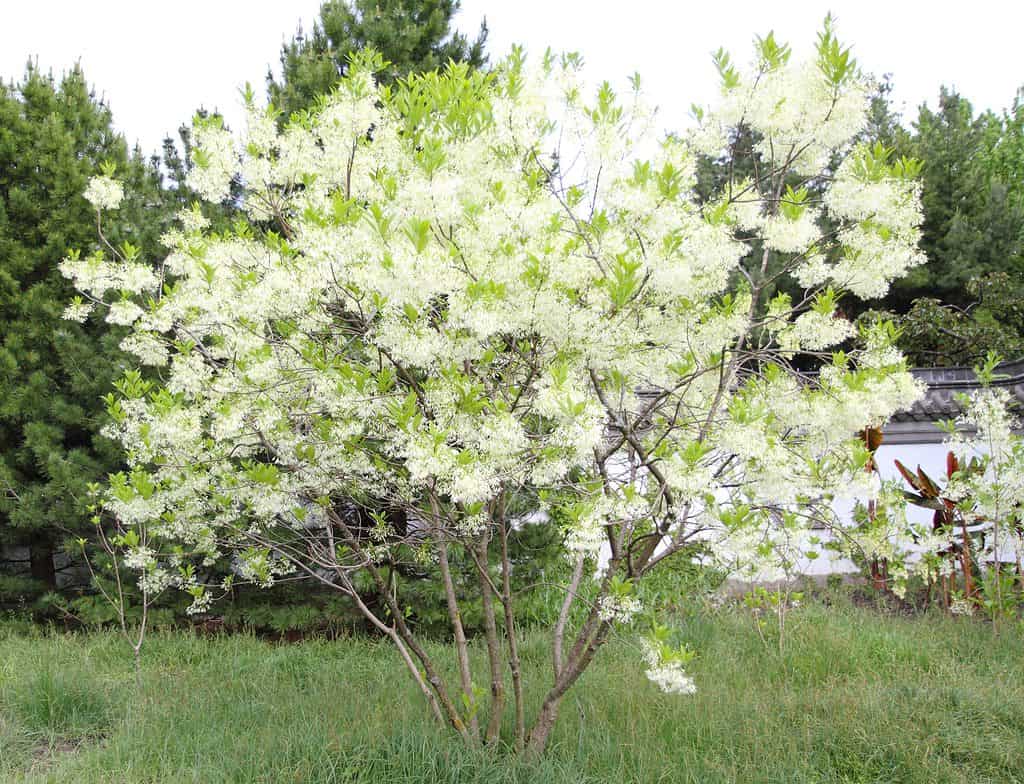
The white fringe tree is similar to a Chinese fringe tree.
The fringe tree is a beautiful, small flowering tree with an oval crown and a delicate, lacy foliage texture. It has silvery-green leaves that shimmer in the sunlight and clusters of white, fragrant flowers in the spring. Growing a fringe tree is straightforward; it prefers well-drained soil and full sun and is tolerant of a wide range of soil pH and wet conditions. Planting in a sheltered location will help it survive harsh winter temperatures.
10. Sweet Bay Magnolia
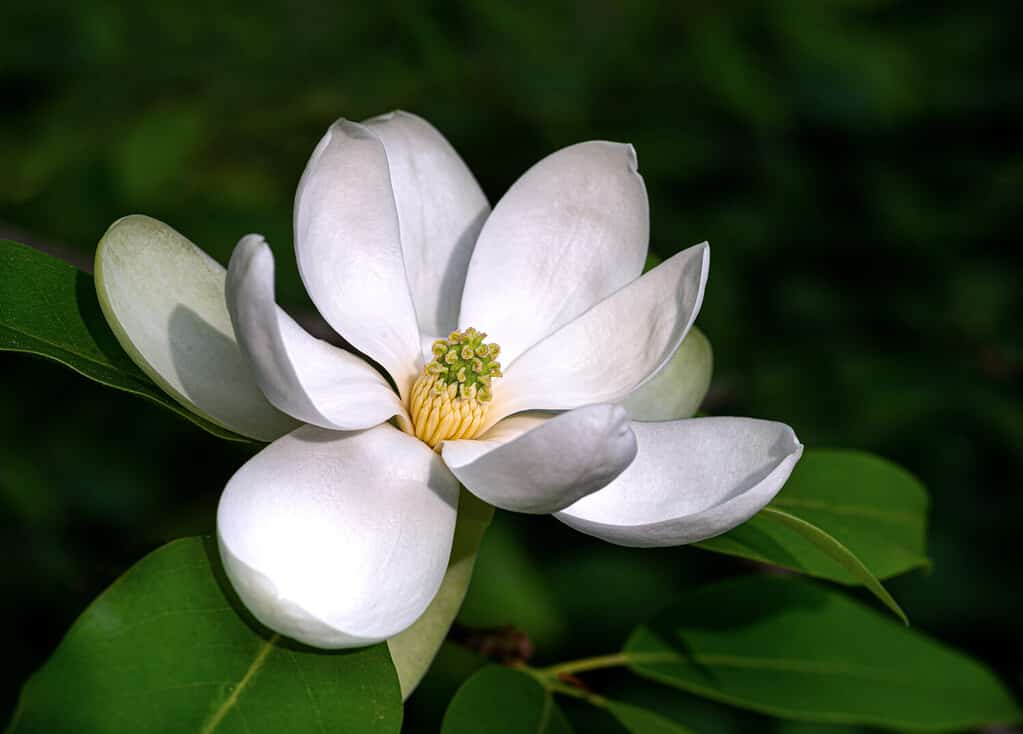
Sweet bay magnolias are a beautiful flowering tree in Pennsylvania.
©Gerry Bishop/Shutterstock.com
A sweet bay magnolia is a beautiful tree with glossy, dark green leaves and fragrant white flowers. The flowers have a yellow center and can grow up to six inches in size. This tree grows best in moist, well-drained soil in full sun and can reach heights up to 25 feet. It is an ideal choice for Pennsylvania landscapes, as it has a classic shape, blooms in the spring, and is easy to maintain.
11. Allegheny Serviceberry
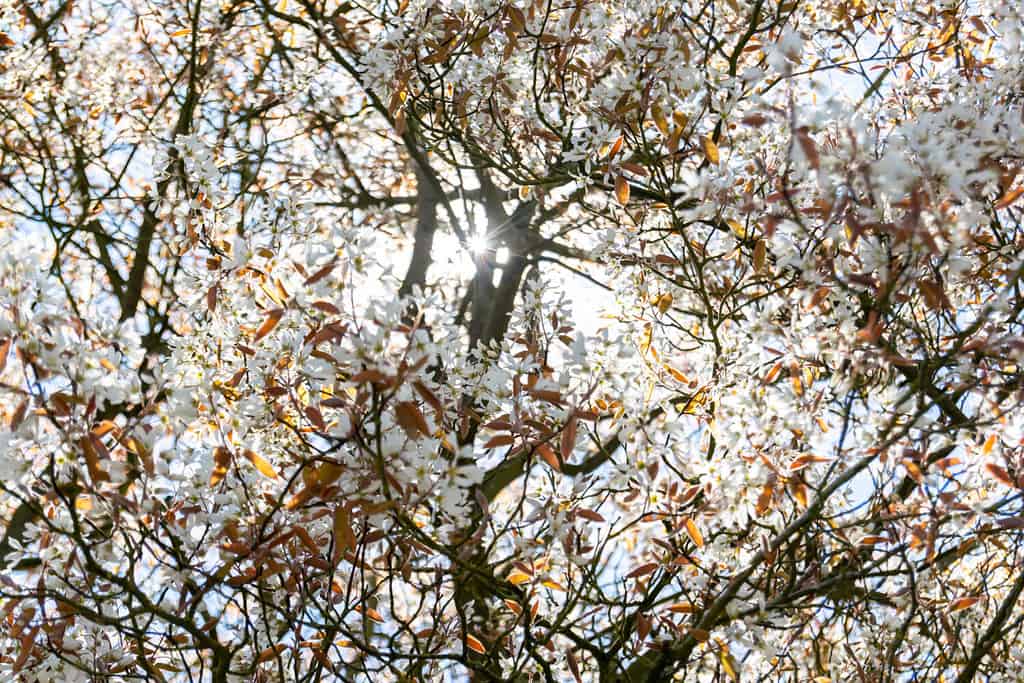
You can’t go wrong with a serviceberry tree. They have so many attractive qualities.
©Wirestock Creators/Shutterstock.com
The Allegheny serviceberry is an attractive deciduous tree with a rounded crown and spreading branches. Its bark is gray-brown and smooth. Its leaves are glossy and dark green, turning yellow and orange in fall. The tree blooms in late spring, with clusters of white flowers followed by small, blue-black, edible fruits. To grow an Allegheny serviceberry, find a spot with full sun and well-drained soil. Plant the tree in the fall, and water it during dry spells. Mulch around the tree to keep the roots cool and moist. Prune the tree in the winter for a more aesthetically pleasing shape.
12. Cornelian Cherry Dogwood

If you want a flowering tree in Pennsylvania with both gorgeous flowers and fruit, pick a cherry dogwood.
©arazu/Shutterstock.com
The Cornelian cherry dogwood is a beautiful and hardy tree boasting bright green leaves and stunning clusters of creamy flowers. Its branches produce bright red fruits in the autumn, adding a splash of color to the landscape. To grow a cherry dogwood tree, plant it in a sunny spot with well-draining soil. Keep it well-watered and mulched, and prune it in early spring to encourage dense growth.
13. Japanese Stewartia

This tree is also called a deciduous Camelia. It is one of the best flowering trees in Pennsylvania.
©lenic/Shutterstock.com
A Japanese stewartia is a stunningly beautiful deciduous tree. It has green, glossy leaves that turn to shades of yellow and scarlet in the autumn. Its bark is unique, with grey-brown ridges that curl away from the trunk in an intriguing pattern. In the spring, the tree blooms with white flowers edged with yellow. To grow a Japanese stewartia, plant it in well-drained, slightly acidic soil in a sunny spot. Water regularly during the summer, and mulch to protect the roots in the winter. With minimal maintenance, this tree will bring years of beauty to any garden.
14. Little-Leaf Linden
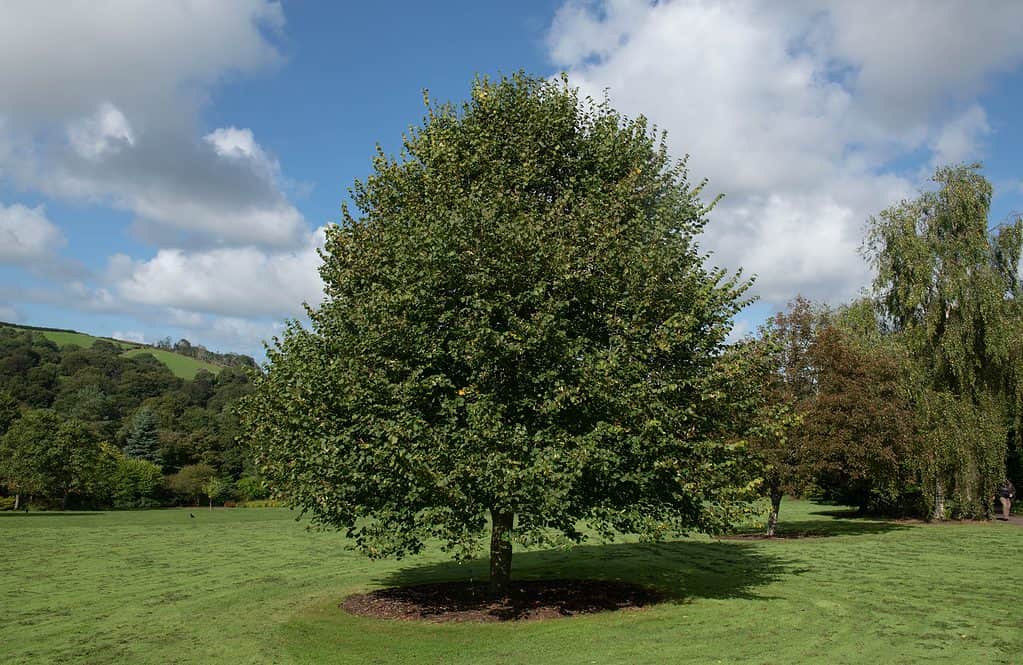
The small-leaved lime tree is also called the little-leaf linden tree.
©Peter Turner Photography/Shutterstock.com
The little-leaf linden is a magnificent tree with a majestic appearance. It has a distinctive pyramidal shape with a broad spreading crown. Its bark is grayish-brown and deeply furrowed. Its leaves are light green in color and fan-shaped, with a toothed margin. Linden flowers are fragrant and yellow-green in color, blooming in the spring. To grow one, plant it in moist, well-drained soil in full to partial sun, then water regularly. Prune as needed to maintain its shape and size. With proper care, the little-leaf linden will become a stunning addition to your landscape.
15. Seven-Sons Tree

The seven-sons tree is related to honeysuckle and has identical flowers.
©Nancy J. Ondra/Shutterstock.com
This tree features seven-lobed leaves and fragrant white flowers. It can reach heights of up to ten feet tall and grows best in full sun. To grow a seven-sons tree, plant a seedling in well-drained soil and water regularly. Fertilize in early spring and prune in late fall to promote healthy growth. This is a fun flowering tree for Pennsylvania gardens.
16. Eastern Redbud
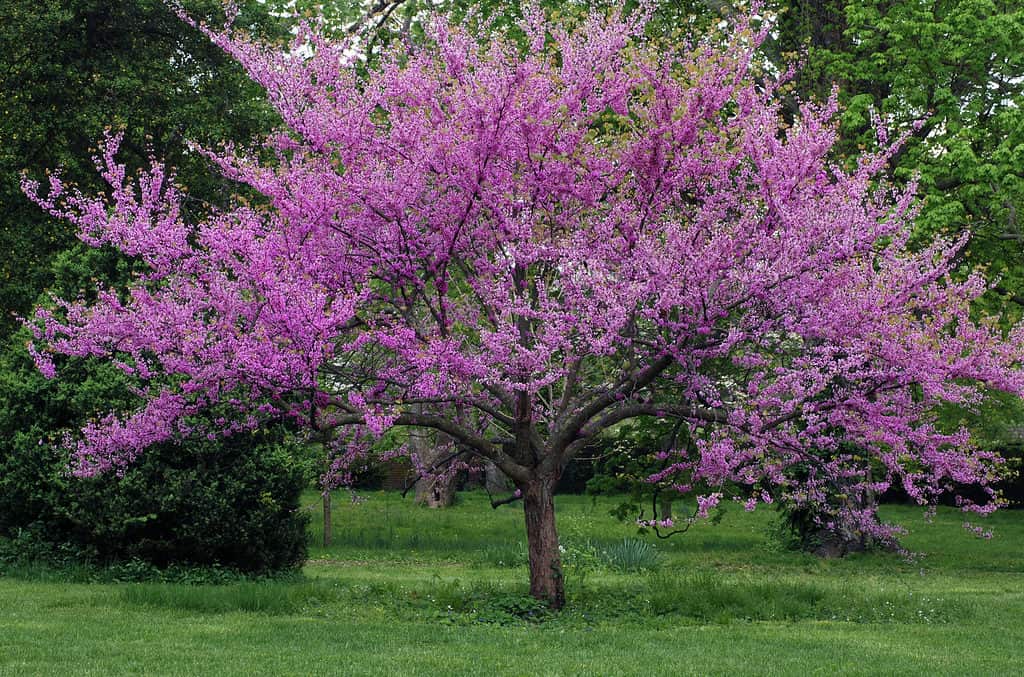
Eastern redbud trees (pictured) grow beautiful lavender-pink flowers and heart-shaped leaves.
©Marie C Fields/Shutterstock.com
The Eastern Redbud is a small deciduous tree with a short, spreading trunk and a rounded crown. Its branches are a deep, glossy green, and its trunk is usually a reddish-brown color. Its leaves are heart-shaped and bright green, and its flowers are small, pink, and clustered along the branches. To grow an Eastern redbud, plant it in an area with full sun to partial shade and moist, well-drained soil. Water it regularly and prune it as needed to maintain its shape.
17. Red Buckeye
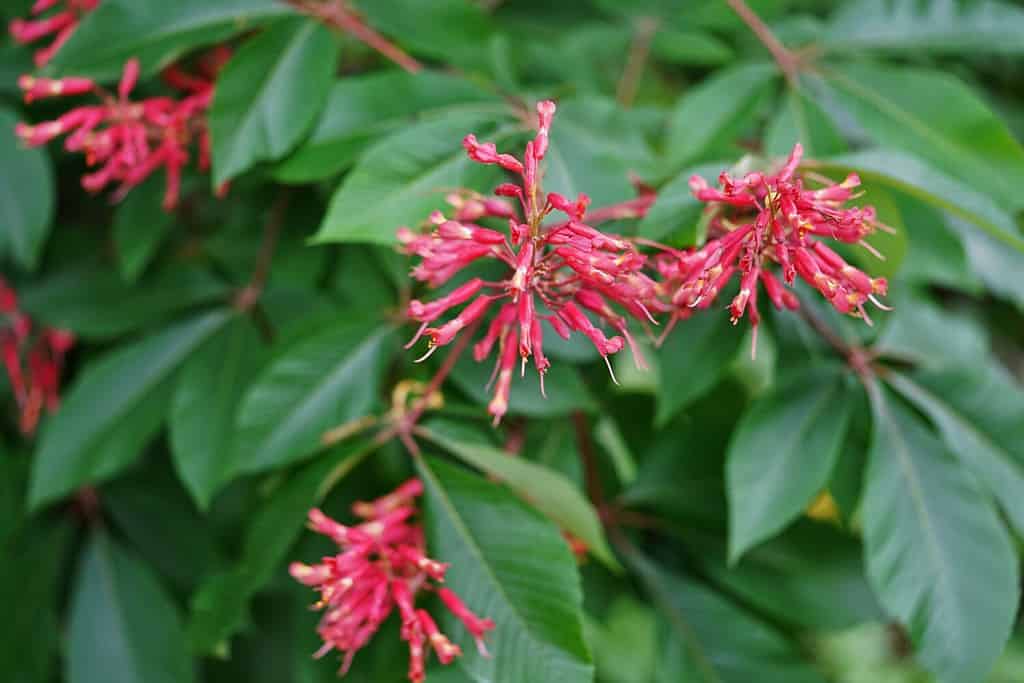
If you need a hardy flowering tree in Pennsylvania, consider the beautiful red buckeye.
©EQRoy/Shutterstock.com
The red buckeye tree is a beautiful sight, with its distinctive red-brown bark and glossy green leaves. Its showy, red flowers in springtime are an impressive sight, standing out against its otherwise deep green foliage. To grow a red buckeye, plant the seeds in moist, well-drained soil and full sun or partial shade. For best results, keep the soil consistently moist during the first season and prune back any dead or diseased branches. With the right conditions, the red buckeye is a great flowering tree for Pennsylvania.
18. Golden Rain Tree

Cassia Fistula Linn is also called the golden shower or rain tree.
©TigerStocks/Shutterstock.com
The golden rain tree is an exquisite sight to behold. Its delicate yellow flowers hang in clusters from its graceful branches, while its lush green leaves give it a bright and vibrant look. This beautiful small tree can grow up to 20 feet in height and is ideal for gardens and other outdoor spaces. To grow a golden rain tree, select a spot in full sun and with well-draining soil. Provide regular deep watering and fertilization twice a year. Prune regularly to maintain shape and remove dead branches. With proper care, this is a majestic flowering tree for Pennsylvania.
19. Black Cherry Tree

If you want a flowering tree in Pennsylvania that also produces edible fruit, black cherry is for you.
©iStock.com/TeleMakro Fotografie (Ina Hensel)
The black cherry tree is a majestic sight, with its lush, dark-green foliage and fragrant pink-white flowers. Its bark is deeply grooved and dark grey in color. Its fruit is a small, round, dark-red cherry. To grow a black cherry tree, choose an area with full sun and moist, well-draining soil. Plant the tree in the spring or fall and water it regularly. Prune the branches to maintain their desired shape and size. With proper care, the black cherry tree will provide years of beauty and delicious fruit.
20. Southern Catalpa
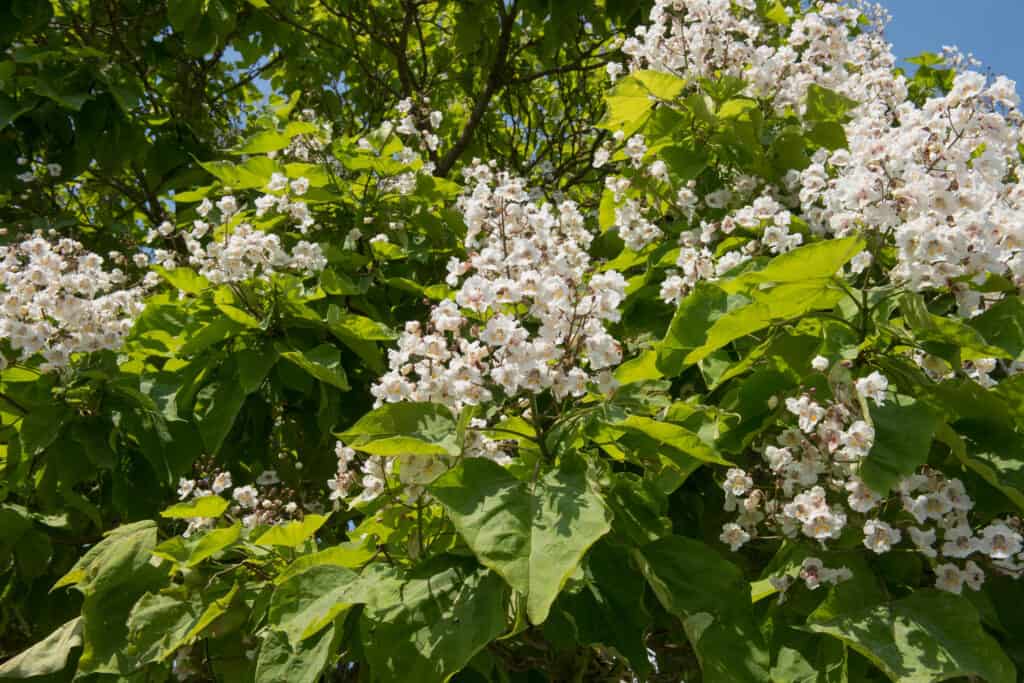
Catalpa bignonioides flowers are a favorite with pollinators.
©Peter Turner Photography/Shutterstock.com
The Southern Catalpa tree is a stunning sight. It has large, heart-shaped leaves and long, drooping flower clusters of white and purple. It grows to a height of up to 30 feet and has a wide, spreading canopy. The bark is smooth, gray, and heavily furrowed. To grow a Southern Catalpa tree, plant in well-drained soil and water thoroughly. Provide ample sunlight and space for it to spread its branches. Fertilize regularly and prune away any dead branches to encourage healthy growth.
21. Apple Tree
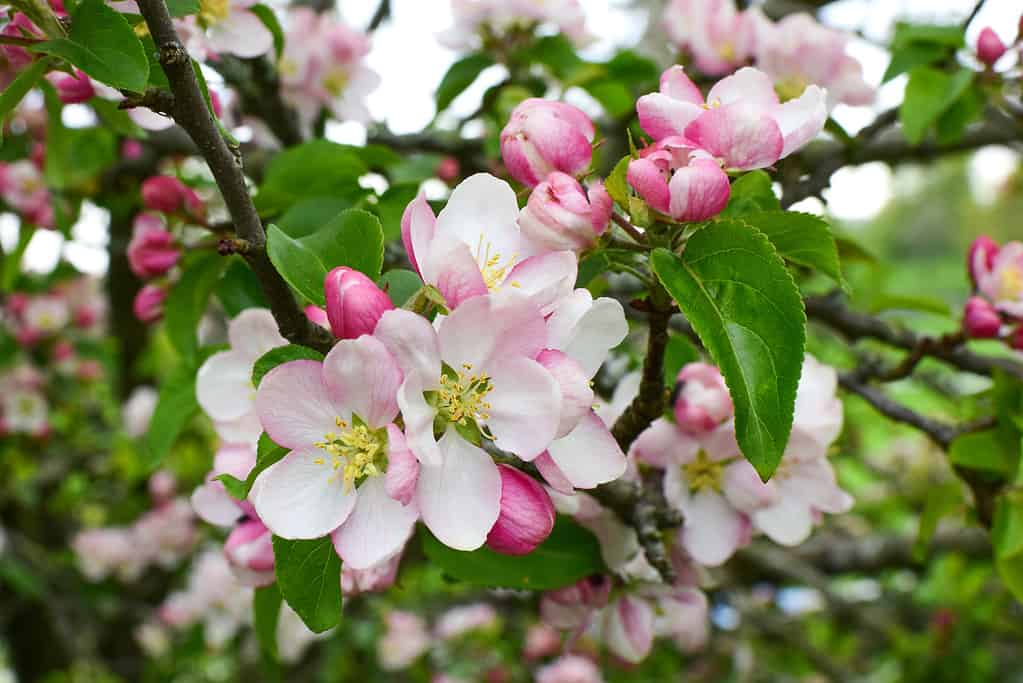
Fruit trees are excellent for attracting bees and butterflies. Hummingbirds love them too.
©AntiD/Shutterstock.com
An apple tree is an attractive deciduous tree with an upright branching structure. Its leaves are bright green and glossy, and its branches are covered in small white flowers in the spring. The tree bears fruits that are round and bright red. To grow an apple tree, plant a sapling in a sunny spot with well-drained soil. Ensure the soil is kept moist and fertilized regularly for best results. Prune the tree annually to promote healthy growth and strong fruiting.
22. American Persimmon Tree
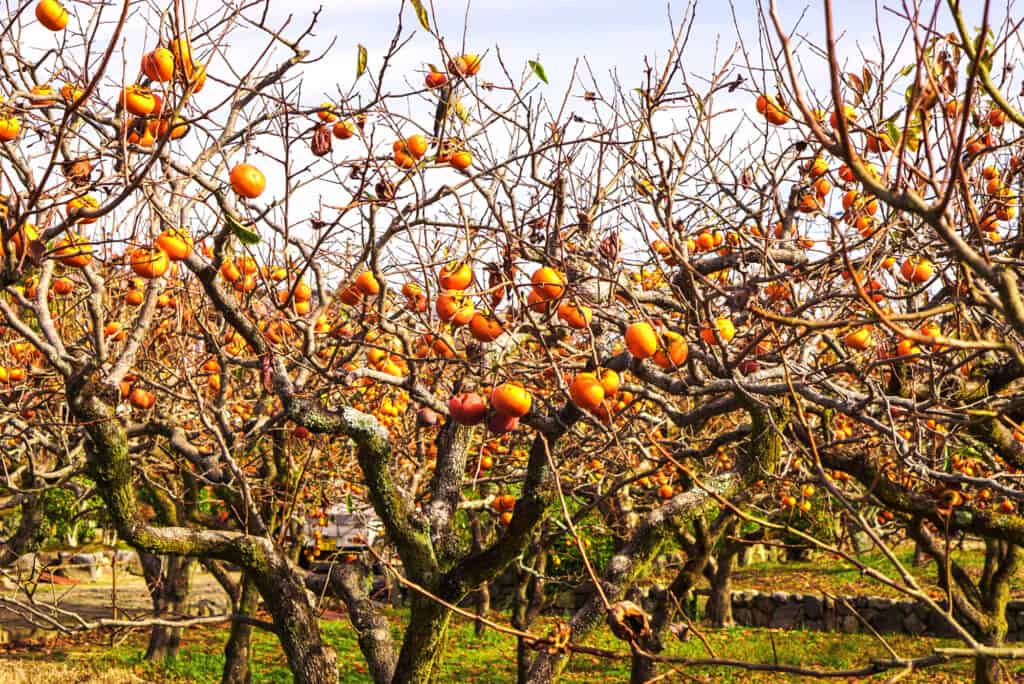
Persimmon trees are hardy flowering trees in Pennsylvania.
©iStock.com/Wiphop Sathawirawong
The American Persimmon Tree is a majestic sight to behold. It sports a broad, round canopy composed of glossy dark green leaves, with clusters of small, fragrant white flowers in the springtime. Its branches are strong and spreading, with smooth, grayish-brown bark and an impressive, stately trunk. In the autumn, its branches are laden with bright orange-red fruit. If you want to grow an American Persimmon Tree, plant it in full sun and well-draining soil. Water regularly and mulch to help the soil retain moisture. Prune in late winter or early spring for best results.
23. Mulberry Tree
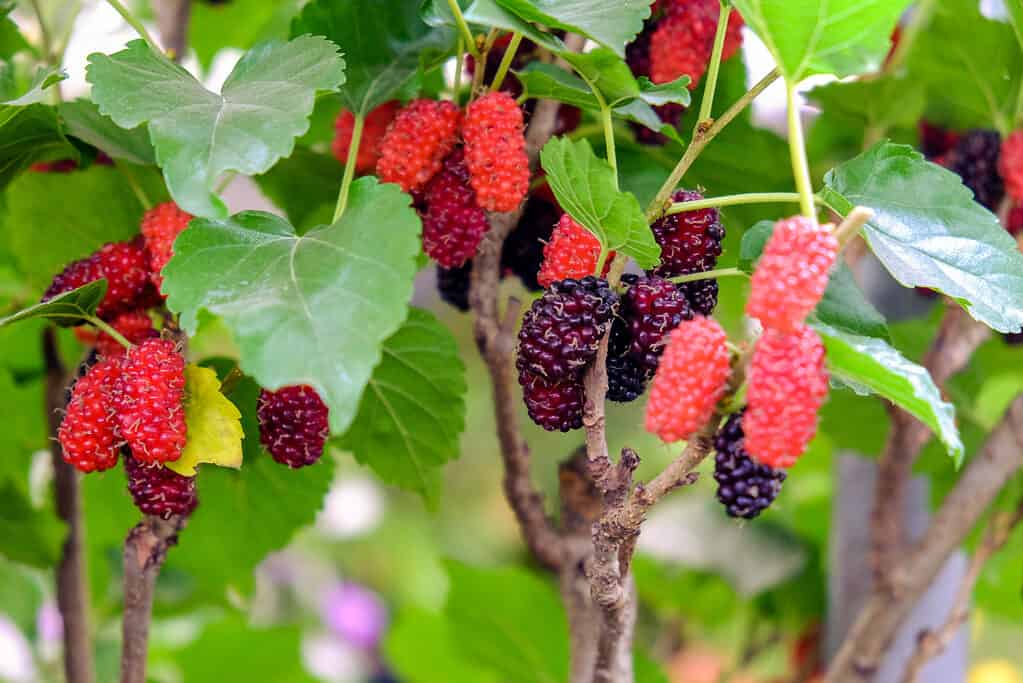
Red mulberry trees grow delicious edible red and purple fruit.
©Aunyaluck/Shutterstock.com
A mulberry tree is a deciduous tree with a spreading, rounded canopy. It features dark green leaves that turn yellow and orange in the fall and long, drooping branches. The tree produces dense clusters of white or pink flowers in the spring, which turn into long, dark purple berries in the summer. To grow a mulberry tree, choose a sunny, well-drained spot and plant it in moist soil. Water it deep and often, and apply mulch or compost to help retain moisture. Prune the tree regularly to maintain its shape and size.
24. Pawpaw Tree
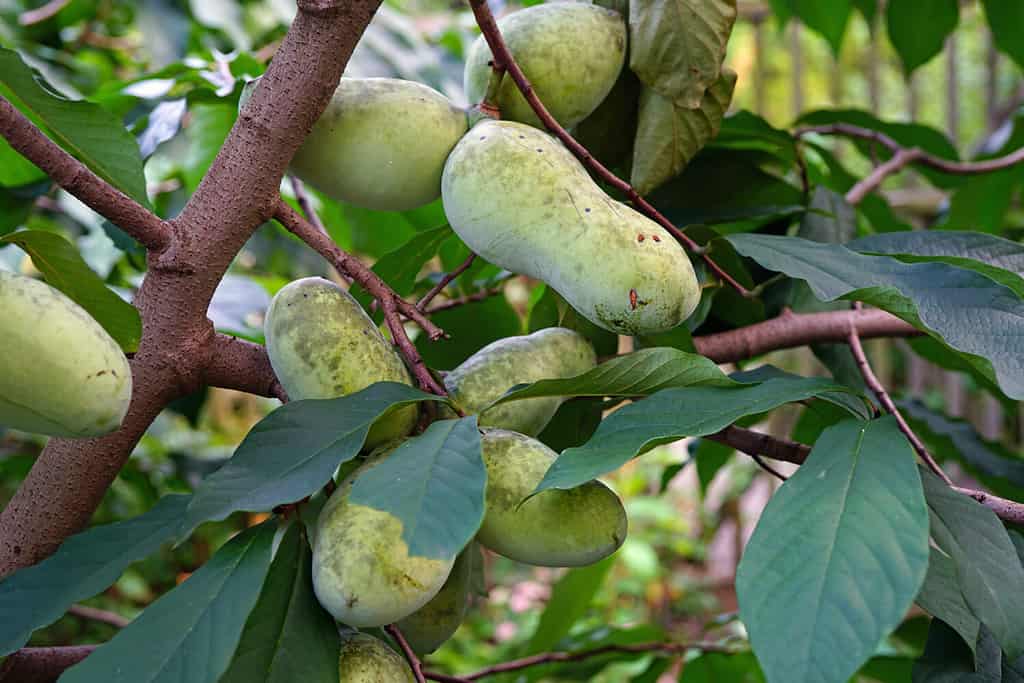
Did you know a pawpaw can weigh two pounds?
©EQRoy/Shutterstock.com
A Pawpaw Tree is an attractive deciduous tree with a rounded canopy and large, drooping leaves. The leaves are typically an olive-green color and can be up to 16 inches long. The tree produces sweet, edible fruit that is yellow-green in color. To grow a Pawpaw Tree, it is best to plant in well-drained soil and full sun. Also, be sure to water regularly and fertilize once a year for optimal growth and fruiting. Prune as needed to maintain a desirable shape. This is one of the best flowering trees for Pennsylvania gardens.
Thank you for reading! Have some feedback for us? Contact the AZ Animals editorial team.






